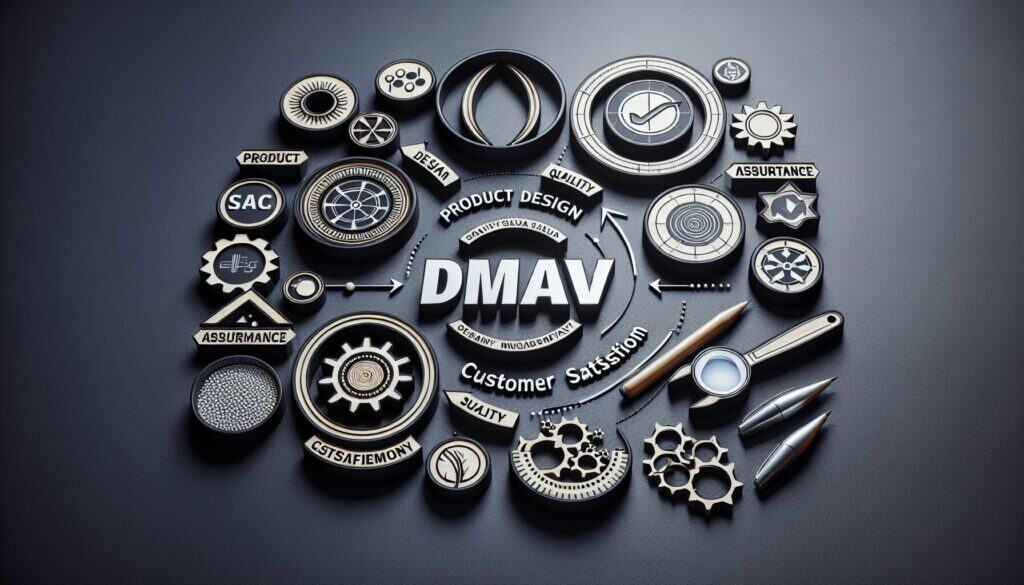DMADV (Define Measure Analyze Design Verify): a Sei Sigma metodologia utilizzata per progettare nuovi prodotti, servizi o processi per soddisfare i requisiti dei clienti e gli obiettivi aziendali con un'elevata qualità.
- Metodologie: Clienti e marketing, Ideazione, Progettazione del prodotto
DMADV

DMADV
- Miglioramento continuo, Esperienza del cliente, Progettazione per Sei Sigma (DfSS), Processo di progettazione, Miglioramento dei processi, Sviluppo del prodotto, Distribuzione delle funzioni di qualità (QFD), Gestione della qualità, Sei Sigma
Obiettivo:
Come si usa:
- Un approccio in cinque fasi: Definire gli obiettivi del progetto e gli obiettivi del cliente; misurare e determinare le esigenze e le specifiche del cliente; analizzare le opzioni di processo per soddisfare le esigenze del cliente; progettare il processo/prodotto per soddisfare le esigenze del cliente; verificare le prestazioni del progetto e la capacità di soddisfare le esigenze del cliente.
Professionisti
- Si concentra sulla progettazione della qualità fin dall'inizio; approccio basato sui dati; mira a soddisfare efficacemente i requisiti dei clienti.
Contro
- Può richiedere risorse e tempo; richiede un approccio strutturato e membri del team qualificati; può essere eccessivamente complesso per attività di progettazione semplici.
Categorie:
- Lean Sigma, Progettazione del prodotto, Qualità
Ideale per:
- Progettare nuovi prodotti o processi, o riprogettare quelli esistenti, per soddisfare le esigenze dei clienti con livelli di qualità Six Sigma.
La metodologia DMADV trova ampia applicazione in diversi settori industriali come quello automobilistico, aerospaziale, dell'elettronica di consumo e sanitario, in particolare quando le organizzazioni cercano di innovare o riprogettare prodotti e servizi. Viene comunemente utilizzata durante le fasi iniziali dei progetti di sviluppo del prodotto, quando l'obiettivo è garantire che i requisiti dei clienti siano soddisfatti con grande precisione. I team composti da product manager, ingegneri, progettisti ed esperti di controllo qualità avviano questo approccio, collaborando strettamente per definire gli obiettivi del progetto e i prodotti da consegnare ai clienti nella fase Define. Durante la fase Measure, la raccolta di dati empirici viene enfatizzata, consentendo ai team di quantificare le esigenze del cliente e di valutare le specifiche attuali rispetto a tali esigenze. Quando analizzano le opzioni di processo disponibili nella fase Analyze, i team utilizzano strumenti statistici avanzati per valutare la fattibilità e la selezione in base a metriche di costo, prestazioni e qualità. La fase di progettazione prevede poi la creazione di prototipi o simulazioni, mentre i test completi della fase di verifica assicurano che il prodotto finale non solo soddisfi ma superi le aspettative dei clienti. Questo approccio metodologico migliora significativamente la qualità del prodotto e la soddisfazione del cliente, inserendo le considerazioni sulla qualità fin dalle prime fasi del processo di sviluppo. Inoltre, riduce al minimo i costi associati alla rilavorazione e alle richieste di garanzia, creando una solida base per le future innovazioni che si adattano all'evoluzione delle richieste dei consumatori. Come tale, il DMADV funge da quadro di riferimento per un processo decisionale sistematico in cui le conclusioni basate sui dati informano ogni fase, promuovendo una cultura di miglioramento continuo all'interno delle organizzazioni.
Fasi chiave di questa metodologia
- Definire gli obiettivi del progetto e gli obiettivi del cliente.
- Misurare e determinare le esigenze e le specifiche del cliente.
- Analizzare le opzioni di processo per soddisfare le esigenze dei clienti.
- Progettare il processo/prodotto per soddisfare le esigenze del cliente.
- Verificare le prestazioni del progetto e la capacità di soddisfare le esigenze del cliente.
Suggerimenti per i professionisti
- Utilizzare strumenti di simulazione avanzati durante la fase di analisi per prevedere con precisione i risultati delle prestazioni in vari scenari.
- Integrare i dati della voce del cliente (VoC) in un processo iterativo. recensioni di designassicurando che l'evoluzione delle esigenze dei clienti influenzi costantemente le decisioni di progettazione.
- Condurre l'analisi delle modalità di guasto e degli effetti (FMEA) durante la fase di progettazione per identificare i problemi potenziali e incorporare misure di ridondanza nelle prime fasi del processo.
Leggere e confrontare diverse metodologie, raccomandiamo il
> Ampio archivio di metodologie <
insieme ad altre 400 metodologie.
I vostri commenti su questa metodologia o ulteriori informazioni sono benvenuti su sezione commenti qui sotto ↓ , così come tutte le idee o i link relativi all'ingegneria.
Contesto storico
1980
1980
1980
1986
1987
1990
1990
1972
1980
1980
1986
1986
1987-03
1990
1990
(se la data non è nota o non è rilevante, ad esempio "meccanica dei fluidi", viene fornita una stima approssimativa della sua notevole comparsa)















Post correlati
Gestione delle operazioni di produzione (MOM)
Sistema di esecuzione della produzione (MES)
Piano di controllo della produzione
Test manuali
Schede di valutazione della movimentazione manuale (MAC)
ManTRA (Strumento di valutazione dei rischi delle attività manuali)